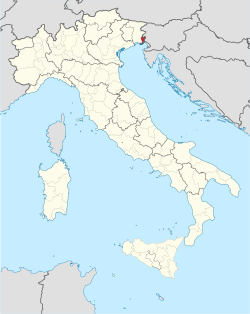Province of Gorizia
Province of Gorizia | |
|---|---|
 Map highlighting the location of the province of Gorizia in Italy | |
| Country | |
| Region | Friuli–Venezia Giulia |
| Capital(s) | Gorizia |
| Comuni | 25 |
| Government | |
| • Commissar | Paolo Viola |
| Area | |
| • Total | 466 km2 (180 sq mi) |
| Population (31 June 2016) | |
| • Total | 139,902 |
| • Density | 300/km2 (780/sq mi) |
| Time zone | UTC+1 (CET) |
| • Summer (DST) | UTC+2 (CEST) |
| Postal code | 34070-34079, 34170 |
| Telephone prefix | 0431, 0481 |
| ISO 3166 code | IT-GO |
| Vehicle registration | GO |
| ISTAT | 031 |
The Province of Gorizia (Italian: Provincia di Gorizia, Friulian: Provincie di Gurize; Slovene: Goriška pokrajina) was a province in the autonomous Friuli–Venezia Giulia region of Italy, which was disbanded on 30 September 2017.
Overview[]
Its capital was the city of Gorizia. It belonged to the Province of Udine between 1924 and 1927 and the communes of Sonzia, Plezzo, Bergogna, Caporetto, Tolmino, Circhina, Santa Lucia d'Isonzo, Gracova Serravalle, Canale d'Isonzo, Cal di Canale, Idria, Montenero d'Idria, Castel Dobra, Salona d'Isonzo, Gargaro, Chiapovano, Aidussina, Santa Croce di Aidùssina, Cernizza Goriziana, Tarnova della Selva, Sambasso, Merna, Ranziano, Montespino, Opacchiasella, Temenizza, Rifembergo, Comeno, San Daniele del Carso, Zolla, Vipacco, San Martino di Quisca and San Vito di Vipacco; and the eastern part of Gorizia, were part of this province between 1918 and 1924, and from 1927 to 1947. These communes are now part of Slovenia.
It had an area of 466 square kilometres (180 sq mi) and a total population of 142,035 (2012). It had a coastal length of 47.6 kilometres (29.6 mi). There were 25 communes in the province.[1]
Around 11% of the population of the province was ethnically Slovenian.[2] Italian legislation ensures the protection of the Slovene linguistic minority in 9 of the 25 municipalities which comprised the province.[3] Three rural municipalities (Doberdò del Lago, Savogna d'Isonzo and San Floriano del Collio) had an ethnically Slovene majority, but the majority of native Slovene speakers in the Province lived in the urban area of Gorizia.
The top ten countries of origin of the inhabitants of Gorizia with foreign citizenship at 31 December 2010 were:[4]
 Bangladesh 1603
Bangladesh 1603 Romania 1153
Romania 1153 Bosnia and Herzegovina 1092
Bosnia and Herzegovina 1092 Croatia 851
Croatia 851 North Macedonia 799
North Macedonia 799 Serbia 646
Serbia 646 Slovenia 502
Slovenia 502 Kosovo[a] 431
Kosovo[a] 431 Albania 427
Albania 427 Ukraine 374
Ukraine 374
See also[]
- Gorizia and Gradisca
- Julian March
- Slovene minority in Italy
Notes[]
- ^ Kosovo is the subject of a territorial dispute between the Republic of Kosovo and the Republic of Serbia. The Republic of Kosovo unilaterally declared independence on 17 February 2008. Serbia continues to claim it as part of its own sovereign territory. The two governments began to normalise relations in 2013, as part of the 2013 Brussels Agreement. Kosovo is currently recognized as an independent state by 97 out of the 193 United Nations member states. In total, 113 UN member states are said to have recognized Kosovo at some point, of which 15 later withdrew their recognition.
References[]
- ^ "Unione delle Province d'Italia (UPI)". Web.archive.org. Archived from the original on 2007-08-07. Retrieved 2020-03-12.
- ^ "UOC (Universitat Oberta de Catalunya)". www.uoc.edu. Retrieved Mar 12, 2020.
- ^ "Archived copy". Archived from the original on 2009-02-06. Retrieved 2009-11-21.CS1 maint: archived copy as title (link)
- ^ ISTAT. "Gorizia". ISTAT. Retrieved 2012-06-06.
External links[]
| Wikimedia Commons has media related to Province of Gorizia. |
- Official website (in Italian) (in Slovene)
Coordinates: 45°56′23″N 13°37′24″E / 45.9398°N 13.6234°E
- Province of Gorizia
- Former provinces of Italy
- Friuli-Venezia Giulia geography stubs

